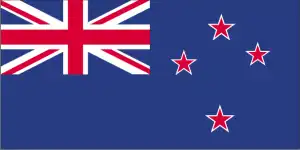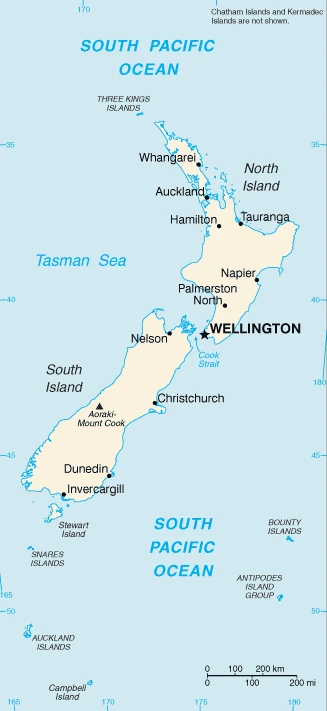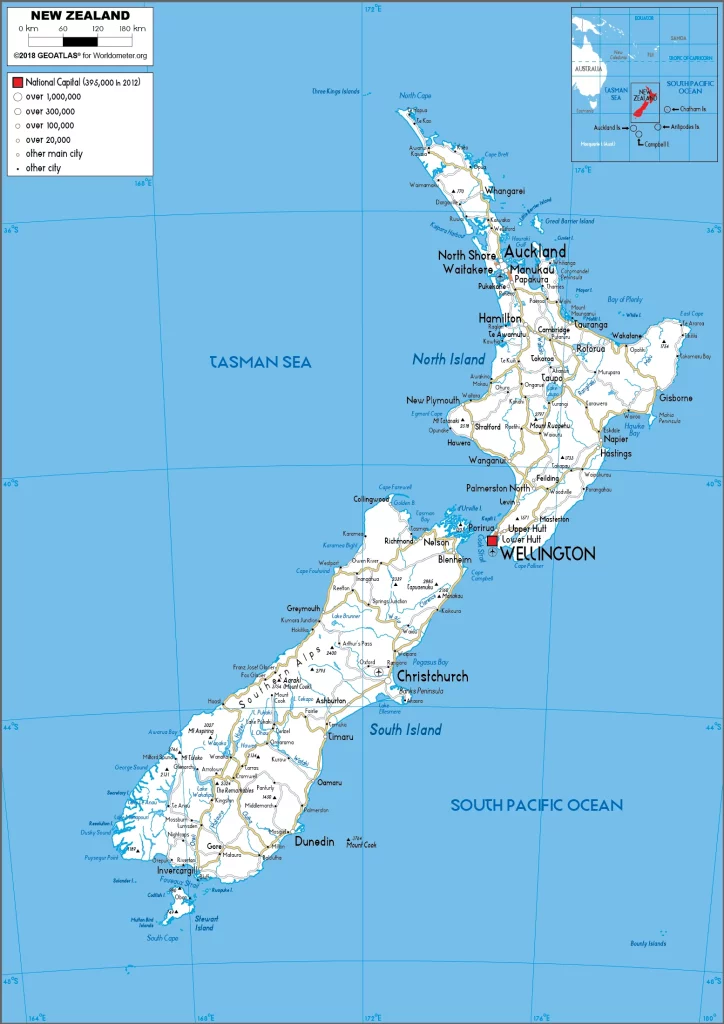New Zealand Google Maps is a site/tool that offers a wide range of map views (topographic, satellite, street view) and navigation options, with little effort on your part, yet efficiently. If you need to plan a trip to a new place like New Zealand, Google maps are available on desktop, mobile, or tablet. This Google maps and information page is dedicated to New Zealand, Oceania (27 countries), showing its location, country facts, details about its capital city Wellington, and plenty of other information which may be interesting when you visit this Oceanian state.
Quick links: Google maps New Zealand, Wellington Google maps, Driving Directions New Zealand, Printable Road Map.

About New Zealand in a nutshell
- Conventional short form of the name: New Zealand
- The conventional long form of the name: none
- Etymology: Dutch explorer Abel TASMAN was the first European to reach New Zealand in 1642; he named it Staten Landt, but Dutch cartographers renamed it Nova Zeelandia in 1645 after the Dutch province of Zeeland; British explorer Captain James COOK subsequently anglicized the name to New Zealand when he mapped the islands in 1769.
- The legal system in New Zealand: common law system, based on English model, with special legislation and land courts for the Maori.
- Climate: Generally temperate and damp. The far north is almost subtropical, whereas southern winters are cold.
- The national symbols are Southern Cross constellation (four, five-pointed stars), kiwi (bird), silver fern; national colors: black, white, red (ochre).
- Internet TLD: .nz
The North Island of New Zealand is dominated by fire, its surface shaped by volcanoes and post-volcanic activity, and the South Island is iced over. The New Zealand Alps range rises to over 3,700 meters along a huge fault line at the boundary of the Austral-Indian and Pacific plates, with glacial lakes and glacial carved ice shelves descending from its peaks. New Zealand has no actual indigenous inhabitants: the Maoris only reached the uninhabited North Island’s shores in waves from Polynesia a thousand years ago. In the second half of the 18th century, James Cook was the first European to land on the islands and take possession of the land on behalf of the British Crown.
Today, one in ten of New Zealand’s four million people boasts Maori ancestry. The two islands each boast a World Heritage Site, a ‘stylistic’ designation in keeping with the island’s character. On the North Island, Tongariro National Park, with its active and extinct volcanoes and relics of Maori culture, was the first site in the World Heritage category, introduced in 1993. The island of ice, the south-western part of the South Island, is occupied by four national parks. Two rare native birds live here: the only species of alpine parrot, the kea, and the endangered flightless takahe. The protected islands of New Zealand’s five nearby Antarctic archipelagos are home to vast colonies of seabirds.
New Zealand was the first country to give women the vote (1893).
Background
Polynesian settlers may have arrived in New Zealand in the late 1200s, with widespread settlement in the mid-1300s. They called the land Aotearoa, which legend holds is the canoe name that Kupe, the first Polynesian in New Zealand, used to sail to the country. The name Aotearoa is now widespread as the local Maori name for the country. Competition for land and resources led to intermittent fighting between different Maori iwi (tribes) by the 1500s as the big game became extinct. Dutch explorer Abel TASMAN was the first European to see the islands in 1642, but he sailed away after an encounter with local Maori. British captain James COOK was the next European to arrive in New Zealand in 1769, followed by whalers, sealers, and traders.
The UK only nominally claimed New Zealand and included it as part of New South Wales in Australia. Concerns about increasing lawlessness led the UK to appoint its first British Resident in New Zealand in 1832, although he had few legal powers. In 1835, some Maori iwi from the North Island declared independence as the United Tribes of New Zealand. Fearing an impending French settlement and takeover, they asked the British for protection. In 1840, the British negotiated their protection in the Treaty of Waitangi, eventually signed by more than 500 different Maori chiefs. Many chiefs did not or were not asked to sign. In the English-language version of the treaty, the British thought the Maori ceded their land to the UK. Still, translations of the treaty appeared to give the British less authority, and land tenure issues stemming from the treaty are still present and actively negotiated in New Zealand.
The UK declared New Zealand a separate colony in 1841 and gave it limited self-government in 1852. Different traditions of authority and land use led to wars from the 1840s to the 1870s fought between Europeans and various Maori iwi. Along with disease, these conflicts halved the Maori population. In the 1890s, New Zealand initially expressed interest in joining independence talks with Australia but ultimately opted against it and changed its status to an independent dominion in 1907. New Zealand provided more than 100,000 troops during each World War, many of whom fought as part of Australia and New Zealand Army Corps (ANZAC). New Zealand reaffirmed its independence in 1947, signed Australia, New Zealand, and US (ANZUS) Treaty, and militarily supported the US in the Korean and Vietnam Wars. In 1984, New Zealand began to adopt nuclear-free policies, contributing to a dispute with the US over naval ship visits that led the US to suspend its defense obligations to New Zealand in 1986. New Zealand has explored reducing some of its ties to the UK in recent years. There is an active minority movement about changing New Zealand to a republic, and in 2015-16, a referendum on changing the New Zealand flag to remove the Union Jack failed 57% to 43%.
Geography
North Island, noted for hot springs and geysers, has the bulk of the population. South Island is primarily mountainous, with eastern lowlands.

Lying in the South Pacific, 990 miles (1600 km) southeast of Australia, New Zealand comprises the North and South Islands, separated by the Cook Strait and many smaller islands.
This state is located in Oceania, islands in the South Pacific Ocean, southeast of Australia, under the coordinates of 41 00 S, 174 00 E, covering an area of 268,838 sq km with a coastline of 15,134 km. New Zealand is almost twice the size of North Carolina, about the size of Colorado.
Predominately mountainous with extensive coastal plains, with Aoraki/mount cook at 3,724 m; as the highest point of New Zealand, while the Pacific Ocean 0 m as the lowest point, causing a mean elevation of 388 m throughout the country. With 268,838 sq km, New Zealand has 264,537 sq km of land and 4,301 sq km of water surface area.
Consists of two main islands and several smaller islands; South Island, the more oversized main island, is the 12th largest island in the world and is divided along its length by the Southern Alps; North Island is the 14th largest island in the world and is not as mountainous, but it is marked by volcanism.
The climate in New Zealand is as follows: Temperate with sharp regional contrasts.
When you visit New Zealand, the natural hazards shall be considered: Earthquakes are common, though usually not severe; volcanic activity volcanism: significant volcanism on the north island; Ruapehu (2,797 m), which last erupted in 2007, has a history of significant eruptions in the past century; Taranaki has the potential to produce dangerous avalanches and lahars; other historically active volcanoes include Okataina, Raoul island, Tongariro, and white island; see note 2 under geography – note.
The following major health-threatening issues shall be considered when visiting New Zealand: none.
Current environmental issues affecting the New Zealand people: water quality and availability; rapid urbanization; deforestation; soil erosion and degradation; native flora and fauna hard-hit by invasive species; adverse effects of climate change.
Google maps New Zealand
The capital and other divisions
Capital city: Wellington found under the coordinates 41 18 S, 174 47 E, applying the time zone UTC+12 (17 hours ahead of Washington, DC, during Standard Time), using the following daylight saving time: +1hr, begins last Sunday in September; ends first Sunday in April.
Wellington is the capital city of New Zealand. Wellington is located on a reasonably small peninsula, making it easy to reach from other parts of the country. It has been nicknamed ‘The City of Sails’. The capital can be compared to the city in England with its large number of buildings and cobbled streets. It is also the country’s major economic center, with many banks and financial institutions. The city has received a lot of attention internationally, notably for its transit innovations and green building boom.
New Zealand became independent on 26 September 1907 (from the UK), and its national holiday is Waitangi Day (Treaty of Waitangi established British sovereignty over New Zealand), 6 February (1840); Anzac Day (commemorated as the anniversary of the landing of troops of the Australian and New Zealand Army Corps during World War I at Gallipoli, Turkey), 25 April (1915).
Administrative divisions: 16 regions and 1 territory*; Auckland, Bay of Plenty, Canterbury, Chatham Islands, Gisborne, Hawkes Bay, Manawatu-Wanganui, Marlborough, Nelson, Northland, Otago, Southland, Taranaki, Tasman, Waikato, Wellington, West Coast.
People and society
Maoris were the first settlers 1200 years ago. Todays majority European population is descended mainly from British migrants who settled after 1840. Maoris living and education standards are generally lower than average. The government is continuing to negotiate the settlement of Maori land claims.
The population in New Zealand is 4,991,442 (July 2021 estimate), with an average of 1.28% (2021 estimate) change. That means New Zealand is the No. 125 in the world’s populated rank list. With an average of 37.2 years median age (36.4 years for males and 36.4 years for women), New Zealand ranks No. 73 on the globe’s median age rank list.
The people living in this country are the New Zealander(s) (noun) or New Zealand (adjective) and belong mainly to the following ethnic groups: European 64.1%, Maori 16.5%, Chinese 4.9%, Indian 4.7%, Samoan 3.9%, Tongan 1.8%, Cook Islands Maori 1.7%, English 1.5%, Filipino 1.5%, New Zealander 1%, other 13.7% (2018 estimate). Note: based on the 2018 census of the usually resident population, percentages add up to more than 100% because respondents could identify more than one ethnic group.
They speak English (de facto official) 95.4%, Maori (de jure official) 4%, Samoan 2.2%, Northern Chinese 2%, Hindi 1.5%, French 1.2%, Yue 1.1%, New Zealand Sign Language (de jure official) 0.5%, other or not stated 17.2% (2018 estimate). Note: shares sum to 124.1% due to multiple responses on the 2018 census languages and practice the following religions: Christian 37.3% (Catholic 10.1%, Anglican 6.8%, Presbyterian and Congregational 5.2%, Pentecostal 1.8%, Methodist 1.6%, Church of Jesus Christ 1.2%, other 10.7%), Hindu 2.7%, Maori 1.3%, Muslim, 1.3%, Buddhist 1.1%, other religion 1.6% (includes Judaism, Spiritualism, and New Age religions, Bahai, Asian religions other than Buddhism), no religion 48.6%, objected to answering 6.7% (2018 estimate), note: based on the 2018 census of the usually resident population; percentages add up to more than 100% because respondents were able to identify more than one religion.
We can conclude the following about the population in New Zealand: Over three-quarters of new Zealanders, including the indigenous Maori, live on the north island, primarily in urban areas. In New Zealand, we are talking about 86.8% (2021) of the total population lives in cities, and most of them reside in the following municipalities: 1.630 million, Auckland, 417,000 Wellington (capital city) (2021).
Industry
Modern agricultural sector; worlds top exporter of dairy products. Dairy vies with tourism as the most significant foreign exchange earner. Hi-tech manufacturing. Open economy. Strong trade links.
Over the past 40 years, the government has transformed New Zealand from an agrarian economy, dependent on concessionary British market access to a more industrialized, free-market economy that can compete globally. This dynamic growth has boosted real incomes but left behind some at the bottom of the ladder and broadened and deepened the technological capabilities of the industrial sector. Per capita income rose for 10 consecutive years until 2007 in purchasing power parity terms but fell in 2008-09. Debt-driven consumer spending drove robust growth in the first half of the decade, fueling a large balance of payments deficit that posed a challenge for policymakers. Inflationary pressures caused the central bank to raise its key rate steadily from January 2004 until it was among the highest in the OECD in 2007 and 2008. The higher rate attracted international capital inflows, strengthening the currency and housing market while aggravating the current account deficit. In recent years, rising house prices, especially in Auckland, have become a political issue and a policy challenge in 2016 and 2017. The ability to afford a house has declined for many. Expanding New Zealand’s network of free trade agreements remains a top foreign policy priority. New Zealand was an early promoter of the Trans-Pacific Partnership (TPP) and was the second country to ratify the agreement in May 2017. Following the United States’ withdrawal from the TPP in January 2017, on 10 November 2017, the remaining 11 countries agreed on the core elements of a modified agreement, which they renamed the Comprehensive and Progressive Agreement for Trans-Pacific Partnership (CPTPP). In November 2016, New Zealand opened negotiations to upgrade its FTA with China; China is one of New Zealand’s most important trading partners.
New Zealand is rich in natural resources: Natural gas, iron ore, sand, coal, timber, hydropower, gold, and limestone.
The main industrial sectors are agriculture, forestry, fishing, logs and wood articles, manufacturing, mining, construction, financial services, real estate services, and tourism.
The country’s export sectors are particularly strong in dairy products, sheep/goat meats, lumber, beef products, and fresh fruits (2019), partnering with these nations: China 28%, Australia 14%, United States 9%, Japan 6% (2019). The export trade resulted in $50.43 billion. Note: Data are in current year dollars (2020 estimate). In a global rank of the export, values resulted in New Zealand’s position of 57.
Land use in New Zealand: 31.4% (2018 estimate) forest, 25.4% (2018 estimate) other.
The arable land area is 1.8% (2018 estimate), and the agricultural land is 43.2% (2018 estimate). Land use for permanent crops 0.3% (2018 estimate), permanent pasture 41.1% (2018 estimate). The sum of the area of the irrigated land is 7,210 sq km (2012).
The main agro-industrial products of New Zealand are milk, beef, kiwi fruit, apples, potatoes, mutton, grapes, wheat, barley, and green onions/shallots.
The country typically needs to import: cars, crude petroleum, refined petroleum, delivery trucks, gas turbines (2019), partnering with the following nations: China 18%, Australia 15%, United States 9%, Japan 6%, Germany 5% (2019) in a sum value of $47.86 billion. Note: data are in current year dollars (2020 estimate) $57.75 billion. Note: data are in current year dollars (2019 estimate) $58.39 billion. Note: data are in current year dollars (2018 estimate). This sum value on the global ranking list of imports resulted in New Zealand 62.
New Zealand Driving Directions
In this post, you learned about New Zealand, Oceania, and southeast Australia. We published some basic information about its capital Wellington, and the New Zealand nation.
Are you interested in visiting New Zealand and looking for driving directions? Click here to plan your route, or see a printable road map of New Zealand below for an overview of the route network.
Printable map of New Zealand
Did you know about New Zealand?
New Zealand, a beautiful country in the Pacific Ocean, is often overshadowed by Australia. However, it has an incredible diversity of people and cultures. You will find Maori culture as well as European settlers. It’s also home to various animals, including kiwis and penguins (although they are not native). New Zealand’s temperate climate means four seasons, with summers typically ranging from 23°C to 27°C and winter temperatures dropping below 0°C.
After virtually visiting New Zealand, you may also be interested in the neighboring countries: none.
If you liked our Google map and New Zealand information page,
please share it with others or save the link https://www.drivingdirections.net in your bookmarks.

